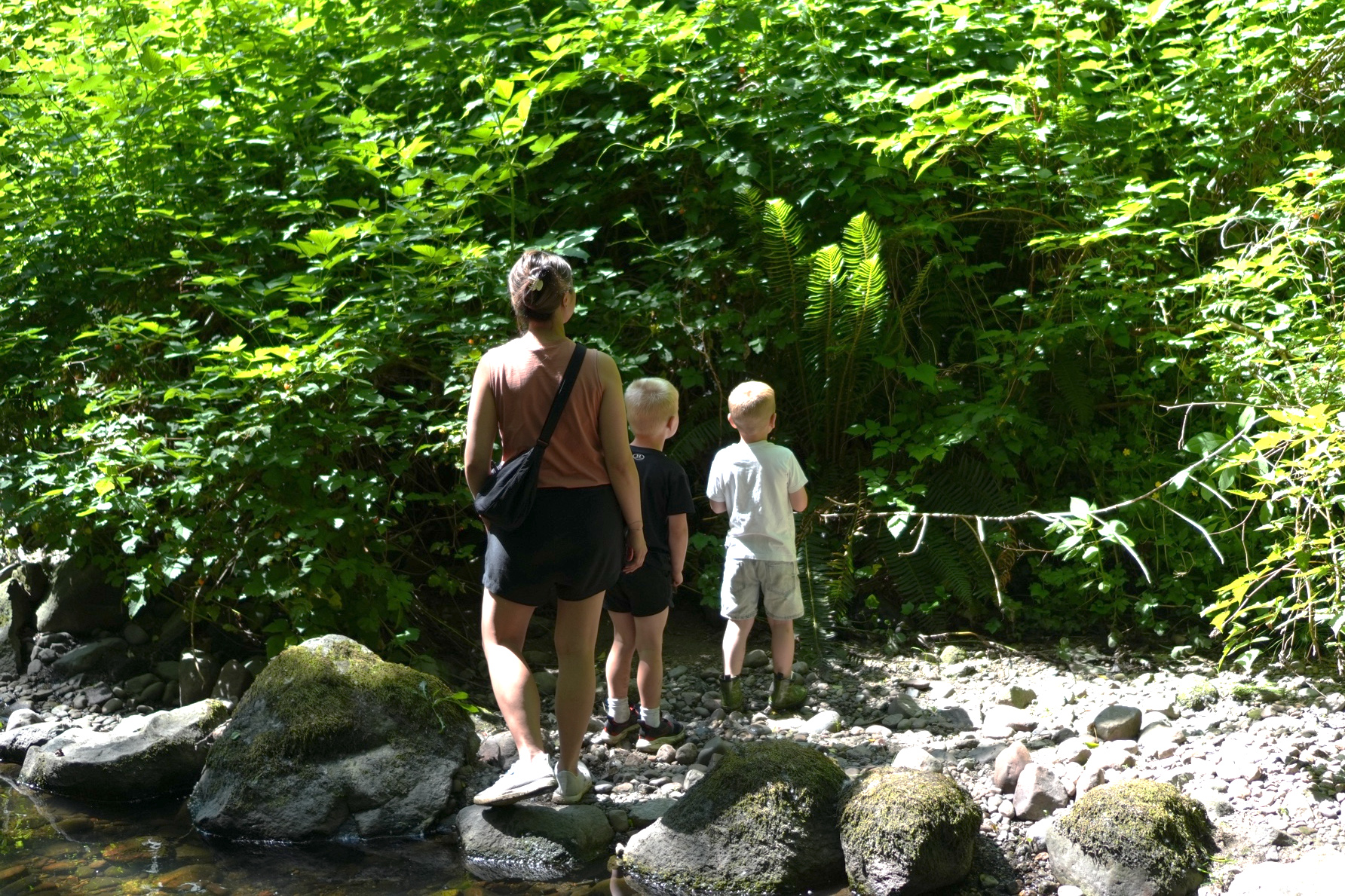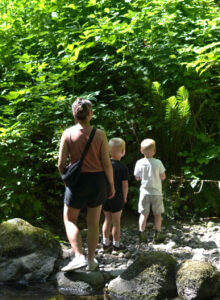
This is a small part of a story of Satellite Pines children and educators with our local ravine, creating new ways of being with the land and waters of this local neighbourhood. This story draws attention to reciprocity, knowing, and gifts from land. Although the core of this inquiry lies with children’s experiences and ravine relations, reflective and responsive work of educators is an essential component that fuels the experience with pedagogical significance. The last piece of documentation includes a reflective piece from Nancy, who is one of the educators who has been knee deep in this living inquiry.
Leigh (Pedagogy & Approach Support Educator)
 At Satellite Pines, the children and educators have been learning about place, our neighbourhood, our area, with waterways. For several months, this project has been inviting the children and educators to experimentations with water movements, to visit the local waterways of our area, and to build ongoing relations with the land. This project asks us to pay attention—or as a protest to the colonial language of transactional relations, I write that we are asked to give/gift our attention.
At Satellite Pines, the children and educators have been learning about place, our neighbourhood, our area, with waterways. For several months, this project has been inviting the children and educators to experimentations with water movements, to visit the local waterways of our area, and to build ongoing relations with the land. This project asks us to pay attention—or as a protest to the colonial language of transactional relations, I write that we are asked to give/gift our attention.
Our experiences of exploring waterways demands a kind of commitment to a particular kind of relationship.
The Renfrew Ravine has been a place that children have been coming into relation with. This relationship is a careful one of giving careful attention to the water, stones, soil, trees, and other lives that live in the ravine.
At the same time, the ravine invites the bare soles of children’s feet into its calm current, the hands of children to reach for the stones as we balance on all four limbs, and our fingers to run through the bushes to reach for its berries.


This isn’t a conventional way of being careful as children are typically asked, where they are asked to take on a “museum mentality” where we “look, but don’t touch” (Sobel, 2012) or on the opposite end, to keep ourselves safe by just looking. This is a different kind of being careful with place. Being careful so that both our bodies and the bodies at the ravine can be in bodily relation without aggression, without harm.


With this kind of being careful, we are asked to be carefully attentive—to slow down, to look closely, to pause. As we carefully give attention, we deepen our understandings of this place... the depths of the water, the trees that spontaneously let go of their leaves (and occasionally fall on our heads), the instability of some stones that lie in the waterway, the branches and roots that are strong enough to hold our hands while climbing, the bushes that yield berries, and much more. Here, reciprocity is key. Perhaps giving our attention means that we are giving a part of ourselves to the ravine, and the ravine—the water, the land—reciprocate to us the gifts that help us know our place.
But we must remember the ravine, the land, the waters, have been here much longer than us. It is when we give ourselves to this place, the space for reciprocity, response, and responsibility opens itself—regardless of whatever shape, form, movement, or inquiry we may encounter within it.
 M: I’m meant to be here.
M: I’m meant to be here.
M: This feels like my real home. I like the forest and I can be one with the animals. The other home is like my play house but this is my real home.
Nancy: How does it feel to be in your real home?
M: It feels good, like I can be here forever.
Nancy’s Reflection (Satellite Pines educator)
M's poignant comment helped me realize how deeply the ravine resonates with us, not just as a place to visit but one to return to. Each time, it invites us to explore further and take notice of the quiet details, like the clay wall and berry bushes growing in abundance. The collective sense of calm we feel in that space makes me wonder if, deep down, we're all seeking a break from the constant motion of everyday life – revealing our instinctive longing to reconnect with nature.
Sobel, D. (2012). Look, don’t touch: The problem with environmental education. Orion Magazine: Examined Life. https://orionmagazine.org/article/look-dont-touch1/
